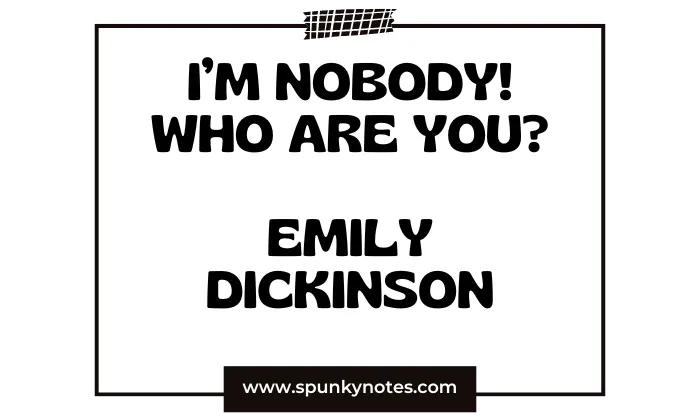

Estimated Reading Time: 7 min
Q. Write a critical appreciation of the poem I’m Nobody! Who Are You? by Emily Dickinson.
A line-by-line analysis of Emily Dickinson’s poem I’m Nobody! Who Are You?
Stanza-1
I’m Nobody! Who are you?
Are you – Nobody – too?
Then there’s a pair of us!
Don’t tell! they’d advertise – you know!
I’m Nobody! Who are you?
The first part, “I’m Nobody!” is a declarative statement made by the speaker. It is a simple yet powerful assertion that the speaker is not a person of importance or high social status.
The speaker distances herself from her time’s societal norms by declaring herself a nobody. She suggests the value of an individual who does not conform to society’s expectations.
In many of Dickinson’s poems, identity is closely tied to social status. She frequently portrays society as a restrictive force that can stifle individuality and creativity.
By declaring herself “Nobody” in the poem “I’m Nobody! Who are you?” Dickinson rejects the idea that one’s worth is determined by social status.
She suggests there is value in being an individual, even if that individual does not conform to society’s expectations. Emily Dickinson often portrays herself as an outsider or a rebel. She challenges the conventions of her time and asserts her individuality.
Are you – Nobody – too?
The speaker, who has identified herself as a “Nobody,” asks the reader if they also consider themselves a “Nobody.” This is not derogatory but, instead, is an invitation to join the speaker in a shared identity that values anonymity over public recognition and fame.
The “Nobody” here might be someone who doesn’t strive for societal acknowledgment or fame. He is someone who values privacy and content without external validation.
It refers to her preference for a reclusive, private life where she could focus on her poetry away from the public eye.
The word “too” in the question implies that the speaker finds comfort and companionship in the idea that others might share this perspective.
There is also an implicit critique of societal norms that value fame and public acknowledgment. It’s a subtle way of forming an ‘us vs them’ dichotomy in the poem I’m Nobody! Who are you?
Then there’s a pair of us — don’t tell!
Upon receiving an affirmative response (implied or imaginary) to her question, “Are you – Nobody – too?” The speaker declares that they make a pair, a duo of ‘Nobodies’.
The phrase “pair of us” emphasizes a sense of companionship and solidarity between the speaker and the reader.
The phrase “Don’t tell!” immediately after declaring their paired identity has a conspiratorial tone. It gives the sense that their shared status as ‘Nobodies’ is a secret to be guarded. It is a special bond that sets them apart from the rest of the world that seeks to be ‘Somebody’.
The exclamation point in “Don’t tell!” implies a sense of urgency or excitement. It suggests that the speaker finds delight or satisfaction in her anonymity.
It also shows the speaker’s disdain for public recognition or advertisement of self, which she further expands on in the poem.
They’d advertise – you know!
The word “they” likely refers to a society or those who value and seek public recognition. “Advertise” suggests promoting oneself or making oneself known to the public, which the speaker seems to view as undesirable.
The phrase “You know!” at the end of this line gives the poem a conversational and somewhat intimate tone. It’s as if the speaker and the reader are co-conspirators in valuing their shared anonymity and privacy.
The exclamation mark at the end adds emphasis and a sense of urgency. Further, it underscores the speaker’s strong feelings about maintaining her status as “Nobody.”
Stanza-2
How dreary – to be – Somebody!
How public – like a Frog –
To tell one’s name – the livelong June –
To an admiring Bog!
How dreary – to be – Somebody!
“Dreary” describes something dull, boring, or lacking in life and excitement. By describing being “Somebody” as “dreary,” the speaker says that achieving fame or public recognition is not as exciting or fulfilling as it might seem.
It suggests that the speaker finds more value and satisfaction in her status as “Nobody.”
This line critiques societal values that emphasize fame and public recognition. Further, the speaker challenges these values, suggesting that being “Somebody” in the public eye is not as desirable as it’s often made out to be.
The use of dashes in this line, as throughout the poem, emphasizes each part of the statement and creates a distinct rhythm. It also reflects Dickinson’s unique style and might represent pauses for thought, adding to the contemplative nature of the poem.
How public – like a Frog –
The speaker sees this state of being “public” as undesirable and a tedious act of self-promotion.
The term “public” illustrates the contrast between the speaker’s preferred state of being a “Nobody” (private, anonymous, reflective) and the societal norm of striving to be a “Somebody” (public, famous, attention-seeking).
A frog is a creature that makes its presence known by croaking loudly, often repetitively.
The comparison of being “Somebody” or a public figure to a frog suggests that the speaker views the pursuit of fame as a mindless and constant need to draw attention to oneself, much like a frog’s continuous croaking.
The phrase “like a Frog” is a specific, vivid image that makes the speaker’s critique of the desire for public recognition more tangible and relatable. Further, it adds a touch of humour and sarcasm to the speaker’s critique.
Capitalization for “Frog” is typical of Dickinson’s style, which emphasizes the word. It also makes the frog image more prominent in the reader’s mind.
The dashes throughout the poem create a unique rhythm and emphasize each part of the statement. They also might represent pauses for thought or a breath, adding to the contemplative, reflective nature of the poem.
To tell one’s name – the livelong June –
The line continues the simile of the frog begun in the previous line of the poem, I’m Nobody! Who are you?
This part of the poem parallels the act of self-promotion (telling one’s name) and the behaviour of a frog that croaks continuously, particularly during its breeding season, which often falls in June.
In this analogy, “telling one’s name” symbolizes the continuous act of self-promotion. The phrase “the livelong June” emphasizes the constant and uninterrupted nature of the act. It also parallels the continuous croaking of a frog throughout the month.
The word “livelong” also underscores the sense of endlessness.
To an admiring Bog!
The line “To an admiring Bog!” completes the simile that started earlier. It compares a public figure to a frog in the poem I’m Nobody! Who are you?
In the poem, Emily Dickinson uses the word “Frog” to symbolize individuals who are constantly seeking public attention or recognition. The “Bog,” then, represents the society that these individuals are trying to impress.
The word “admiring” suggests that the Bog, or society, admires the Frog’s constant croaking (or, in the case of the metaphor, a person’s constant self-promotion).
However, it’s important to consider the nature of a bog. A bog is a type of wetland, a passive part of the landscape that, being non-sentient, cannot truly admire anything. It simply exists.
Dickinson compares society to a “Bog,” implying criticism of constant self-promotion. She suggests that the attention earned through such behaviour may be shallow. Further, the admiration resulting from self-promotion might ultimately be meaningless.
The phrase “the livelong June” emphasizes the constant and uninterrupted nature of the act, drawing a parallel to the continuous croaking of a frog throughout the month.
The speaker, who identifies as “Nobody,” seems to find more value and satisfaction in privacy away from the public eye.
Further, the poem suggests that the peace and authenticity found in being “Nobody” might be more fulfilling than the shallow admiration received in the pursuit of being “Somebody.”
Emily Dickinson’s “I’m Nobody! Who are you?” embraces anonymity, while “I Felt a Funeral in My Brain” portrays the mind’s disintegration. Both reflect on private selfhood.


